Assessment of Various Structures of HRM
21 Pages6021 Words33 Views
Added on 2020-03-02
Assessment of Various Structures of HRM
Added on 2020-03-02
ShareRelated Documents
HUMAN RESOURCES MANAGEMENT
1
1
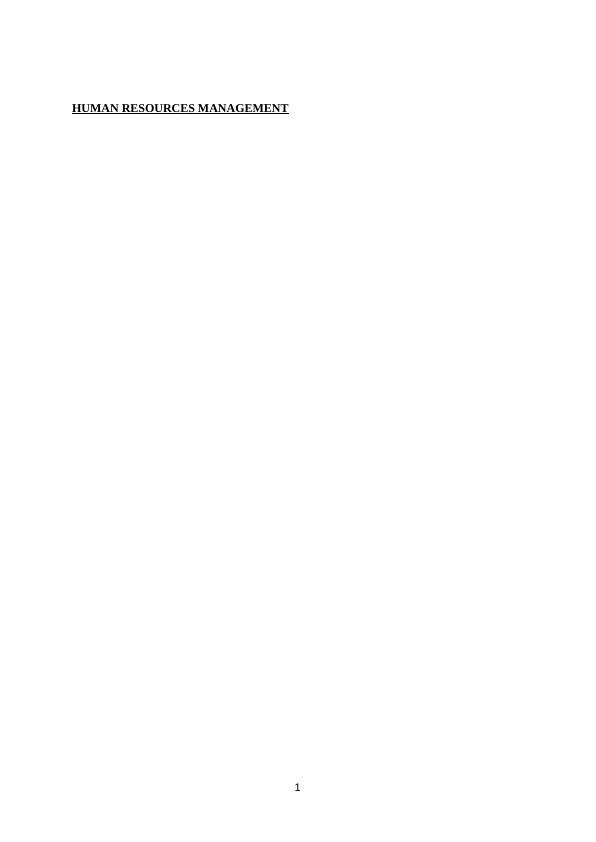
Table of Contents
Introduction............................................................................................................................................3
Background information about the company..........................................................................................3
HR Strategy............................................................................................................................................4
SHRM/HRMS...................................................................................................................... 4
Relevant models/theories on SHRM........................................................................................4
Importance of HRM..............................................................................................................6
Assessment of various structures of HRM................................................................................7
Formulating and implementing the HR strategies..................................................................................9
Assessing the strategic human resource procedure.....................................................................9
Responsibilities in SHRM (Strategic Human Resource Management).......................................10
Creation of HR Strategies.....................................................................................................11
Implementation of HR Strategies..........................................................................................11
Application of HR Strategies................................................................................................................12
Assortment of HR Strategies.................................................................................................13
Recommendations on how the company’s HR can become more strategic.................................14
Conclusion...........................................................................................................................................18
2
Introduction............................................................................................................................................3
Background information about the company..........................................................................................3
HR Strategy............................................................................................................................................4
SHRM/HRMS...................................................................................................................... 4
Relevant models/theories on SHRM........................................................................................4
Importance of HRM..............................................................................................................6
Assessment of various structures of HRM................................................................................7
Formulating and implementing the HR strategies..................................................................................9
Assessing the strategic human resource procedure.....................................................................9
Responsibilities in SHRM (Strategic Human Resource Management).......................................10
Creation of HR Strategies.....................................................................................................11
Implementation of HR Strategies..........................................................................................11
Application of HR Strategies................................................................................................................12
Assortment of HR Strategies.................................................................................................13
Recommendations on how the company’s HR can become more strategic.................................14
Conclusion...........................................................................................................................................18
2
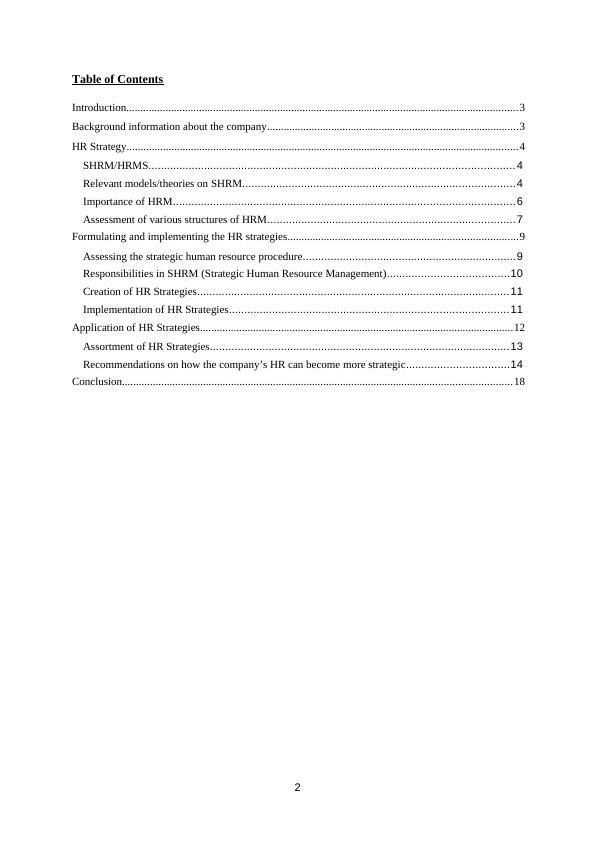
Introduction
An organization is made up of many individuals (Brannick, Levine and Morgeson, 2007).
These individuals who work together as a business' workers are termed as the employees and
known as the human resources. This form a department is known as the human resources
department or HRD which has all the scope of work force issues such as recruitment, training
and motivation. Basically, the department that works towards managing the workforce in a
business is termed as the human resources management (HRM). The HRM is one which
deals with concern is linked with individuals like their pay packages, recruitment,
performance management, employee issues such as motivation, remuneration, wellness,
protection, safety, services, facilities and training, communication and everything which
concerns on is concerned with the workers. The HRM focuses towards managing culture of
the workplace and its environment (Ashton and Felstead, 2001).
The successful HRM allows the workers to make efficient and productive contribution
towards the entire business' goals and its achievements (Heath field, 2015).
Background information about the company
In order to understand the strategic HRM, the case study of CIT i.e. complete IT has been
considered. It is a UK-based business which provides with IT support services by making the
local IT support available to the SMEs (Complete IT, 2017). This business has
been into operation from past two decades. The businesses into providing high level of
technical skills and services for resolving the IT link problems. The motive of this
organisation is not to just fix the issues but also to look for the ways so that the systems can
be improved with a positive impact on the business of the clients. They have a huge range of
services which involves the spontaneous support along with the proactive management of
customers’ information technology. They offer customised services for all of their clients.
3
An organization is made up of many individuals (Brannick, Levine and Morgeson, 2007).
These individuals who work together as a business' workers are termed as the employees and
known as the human resources. This form a department is known as the human resources
department or HRD which has all the scope of work force issues such as recruitment, training
and motivation. Basically, the department that works towards managing the workforce in a
business is termed as the human resources management (HRM). The HRM is one which
deals with concern is linked with individuals like their pay packages, recruitment,
performance management, employee issues such as motivation, remuneration, wellness,
protection, safety, services, facilities and training, communication and everything which
concerns on is concerned with the workers. The HRM focuses towards managing culture of
the workplace and its environment (Ashton and Felstead, 2001).
The successful HRM allows the workers to make efficient and productive contribution
towards the entire business' goals and its achievements (Heath field, 2015).
Background information about the company
In order to understand the strategic HRM, the case study of CIT i.e. complete IT has been
considered. It is a UK-based business which provides with IT support services by making the
local IT support available to the SMEs (Complete IT, 2017). This business has
been into operation from past two decades. The businesses into providing high level of
technical skills and services for resolving the IT link problems. The motive of this
organisation is not to just fix the issues but also to look for the ways so that the systems can
be improved with a positive impact on the business of the clients. They have a huge range of
services which involves the spontaneous support along with the proactive management of
customers’ information technology. They offer customised services for all of their clients.
3
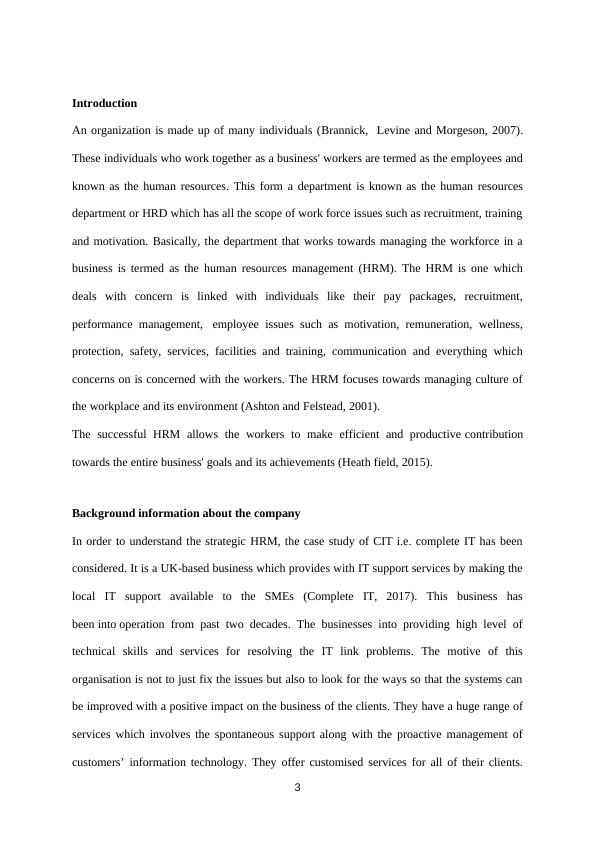
The vision is to provide with the IT support in a passionate and committed manner so that the
client experiences pleasant, sincere and trouble free services.
HR Strategy
SHRM/HRMS
The strategic HRM is one of the anticipatory or defensive management styles of workers in
the business (Freeman, 2004). Elaborating the same, it is an approach where in the human
resources are managed by bringing a strategic arrangement for maintaining long term goals of
the business.
Relevant models/theories on SHRM
There are three main theories of strategic HRM which are utilised in modern human
resources management (Kaler, 2002). Like different big businesses, CIT also applies these
theories:
Universalistic technique
This technique is also termed as the best practices theory which has assumption that the high
performance results in the business can be attained through predefined sets of human
resource managing activities. These activities can be segregated into groups of four policy
objectives which are
Flexibility: the modern employees look forward to flexibility at their place of work
(Reilly, 2009). The managers must make sure that flexibility is provided so that the staff
members are kept engaged and motivated towards delivery of high productivity (Jamrog
and Overholt, 2014)
Quality: the reality that the workers have to always be kept contented and encouraged for
making them perform at their maximum should not be ignored.
4
client experiences pleasant, sincere and trouble free services.
HR Strategy
SHRM/HRMS
The strategic HRM is one of the anticipatory or defensive management styles of workers in
the business (Freeman, 2004). Elaborating the same, it is an approach where in the human
resources are managed by bringing a strategic arrangement for maintaining long term goals of
the business.
Relevant models/theories on SHRM
There are three main theories of strategic HRM which are utilised in modern human
resources management (Kaler, 2002). Like different big businesses, CIT also applies these
theories:
Universalistic technique
This technique is also termed as the best practices theory which has assumption that the high
performance results in the business can be attained through predefined sets of human
resource managing activities. These activities can be segregated into groups of four policy
objectives which are
Flexibility: the modern employees look forward to flexibility at their place of work
(Reilly, 2009). The managers must make sure that flexibility is provided so that the staff
members are kept engaged and motivated towards delivery of high productivity (Jamrog
and Overholt, 2014)
Quality: the reality that the workers have to always be kept contented and encouraged for
making them perform at their maximum should not be ignored.
4
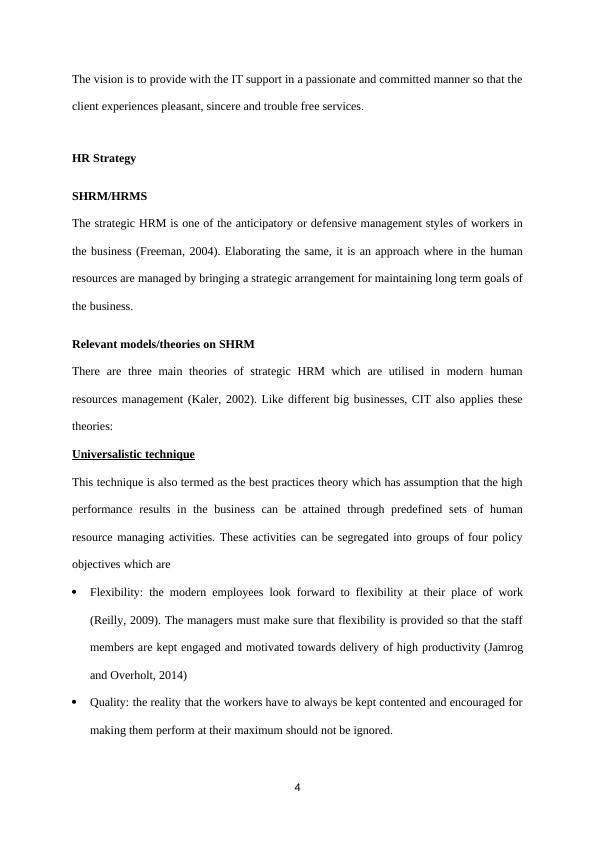
Strategy integration: the human resource management has to be integrated with the
strategy plans of the business. This would ensure that human resource management
becomes an element of CIT's entire business strategy. Also it has to be made sure that the
line managers utilise that HRM strategies in their daily working (Barney,2005).
Commitment: it is important that the HRM activities confirm to the loyalty of staff
members of the business so that the best performance can be expected from them (Buller
and McEvoy, 2012).
Yet it is to be kept in mind that as per Guest all of these theories would work only when they
are combined and they are not useful for attaining business goals, when they are separated
(Hodge, Anthony and Gales, 2003).
Fit or Contingency Approach:
The HR arrangements and activities have to be created in such a manner that they match up
to the business goals and plans. This would help in attaining the maximum performance.
When the human resource and business strategies are synchronised then it is known as a
"vertical fit". This technique is termed to be the "best fit technique ". The best fit technique
encourages that the business strategies and human resource strategies have to be in alignment.
For this there are three models:
Strategy configuration: within this model it is stated that the business can we on the
functioning mode if they are capable of implementing tactical configuration strategies
depending on the type of business (Campbell, Coff and Kryscynski, 2012).
Life-cycle model: the business life-cycle is usually of four stages which are start-up,
development, maturity and declining stage (Jiang, Lepak, Han, Hong, Kim, and Winkler,
2012). The human resources department has to be fully aware of the present stage of the
5
strategy plans of the business. This would ensure that human resource management
becomes an element of CIT's entire business strategy. Also it has to be made sure that the
line managers utilise that HRM strategies in their daily working (Barney,2005).
Commitment: it is important that the HRM activities confirm to the loyalty of staff
members of the business so that the best performance can be expected from them (Buller
and McEvoy, 2012).
Yet it is to be kept in mind that as per Guest all of these theories would work only when they
are combined and they are not useful for attaining business goals, when they are separated
(Hodge, Anthony and Gales, 2003).
Fit or Contingency Approach:
The HR arrangements and activities have to be created in such a manner that they match up
to the business goals and plans. This would help in attaining the maximum performance.
When the human resource and business strategies are synchronised then it is known as a
"vertical fit". This technique is termed to be the "best fit technique ". The best fit technique
encourages that the business strategies and human resource strategies have to be in alignment.
For this there are three models:
Strategy configuration: within this model it is stated that the business can we on the
functioning mode if they are capable of implementing tactical configuration strategies
depending on the type of business (Campbell, Coff and Kryscynski, 2012).
Life-cycle model: the business life-cycle is usually of four stages which are start-up,
development, maturity and declining stage (Jiang, Lepak, Han, Hong, Kim, and Winkler,
2012). The human resources department has to be fully aware of the present stage of the
5
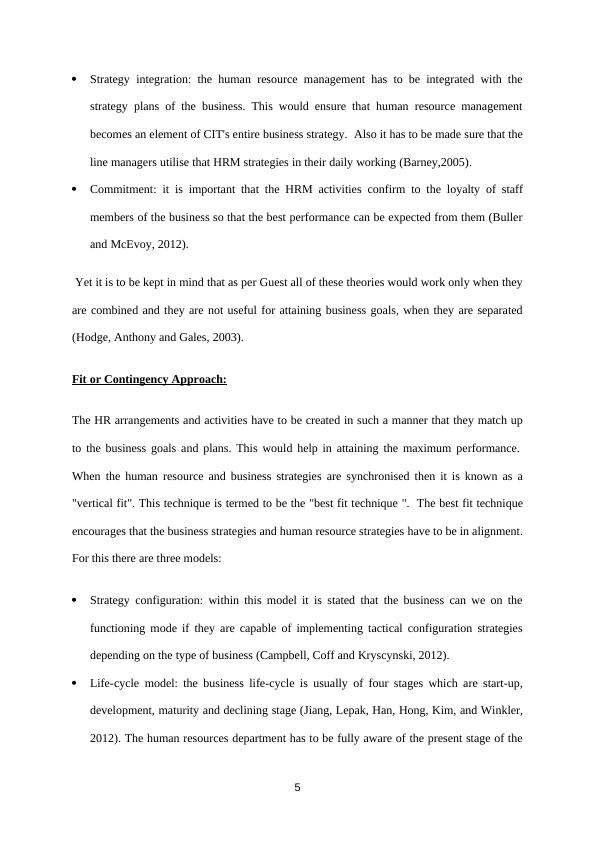
business so that the appropriate strategy can be made for meeting the needs of the current
phase.
Best fit and competitive policy: The three competences of strategies are focus or niche
creation, cost leadership and quality. It is important that CIT applies competitive
strategies so that the maximum performance can be achieved. It is also significant as there
has been a rise in the competition and the business must have a competitive edge.
The Configurationally Perspective:
This model manages the significance of outline of various HR strategies and in the manner
these strategies have impact on business performance. This means the strategies can be
termed as the independent variables and the performance of the business can be termed as the
dependent variable.
Importance of HRM
In CIT, HRM is seen to be the top most effective factors for the business. The HR
management importance can be segregated into below given set of activities:
Enrolment and training: it involves recruitment of new individual At CIT and training
them with respect to the needs of the business. Therefore it is the key responsibility of the
HRM of CIT to carry out that enrolment and training. The vacancies have to be filled up
in the business and for this the HR manager makes sure that arrangements are made and
testing is done for the potential candidates (Godard, 2004). The HR functions also lay
down the rules and regulations of the agreement that occur among the workers and the
business.
Performance assessments: the human resource management and courage is the workers to
perform in the best manner (Millmore, Lewis, Saunders, Thornhill and Morrow, 2007).
6
phase.
Best fit and competitive policy: The three competences of strategies are focus or niche
creation, cost leadership and quality. It is important that CIT applies competitive
strategies so that the maximum performance can be achieved. It is also significant as there
has been a rise in the competition and the business must have a competitive edge.
The Configurationally Perspective:
This model manages the significance of outline of various HR strategies and in the manner
these strategies have impact on business performance. This means the strategies can be
termed as the independent variables and the performance of the business can be termed as the
dependent variable.
Importance of HRM
In CIT, HRM is seen to be the top most effective factors for the business. The HR
management importance can be segregated into below given set of activities:
Enrolment and training: it involves recruitment of new individual At CIT and training
them with respect to the needs of the business. Therefore it is the key responsibility of the
HRM of CIT to carry out that enrolment and training. The vacancies have to be filled up
in the business and for this the HR manager makes sure that arrangements are made and
testing is done for the potential candidates (Godard, 2004). The HR functions also lay
down the rules and regulations of the agreement that occur among the workers and the
business.
Performance assessments: the human resource management and courage is the workers to
perform in the best manner (Millmore, Lewis, Saunders, Thornhill and Morrow, 2007).
6
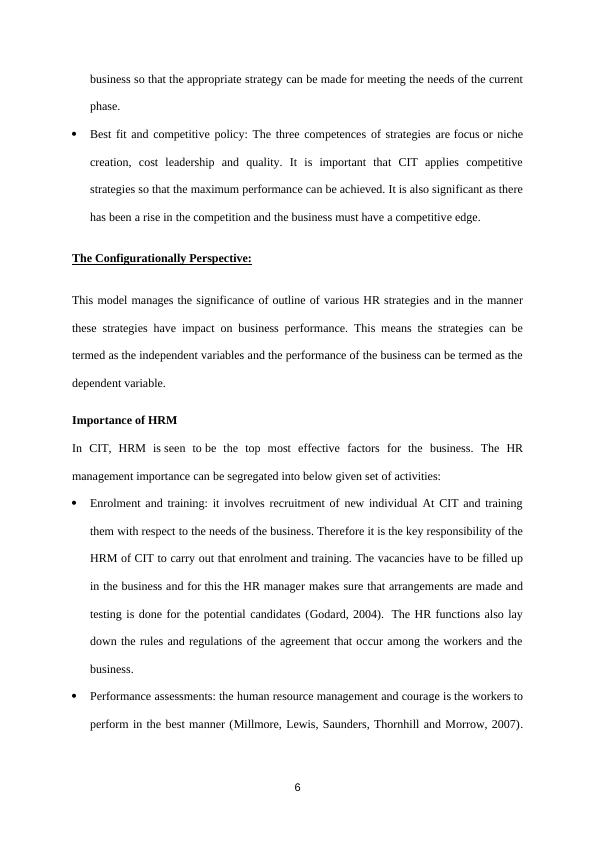
End of preview
Want to access all the pages? Upload your documents or become a member.
Related Documents
Functional Aspects of Managing People in Indian Healthcare Systemlg...
|10
|2679
|44
Strategic Human Resource Management for East Baylg...
|23
|953
|96
Strategic Human Resource Managementlg...
|13
|3381
|58
(HRM)Strategic Human Resource Management Assignmentlg...
|17
|4122
|123
Relationship between Business Strategy and Human Resource Strategylg...
|14
|4043
|35
Importance of Strategic Human Resource Management in Business Enterpriseslg...
|10
|847
|225
